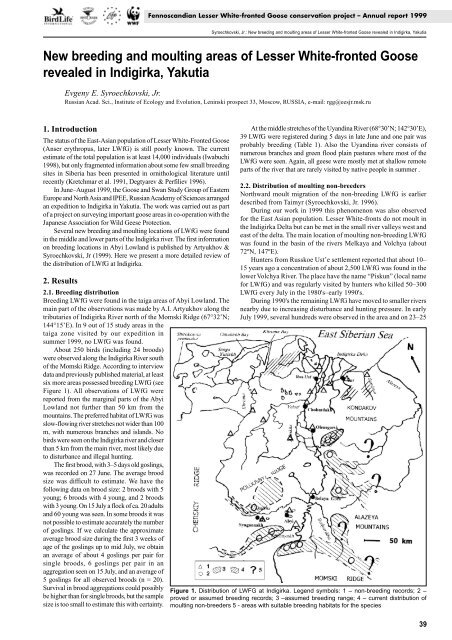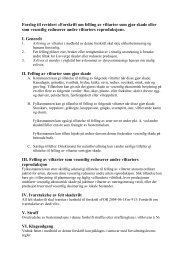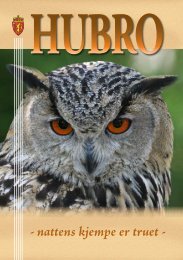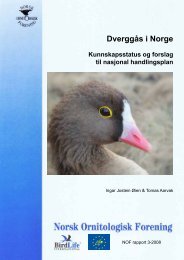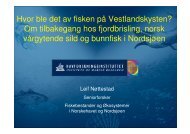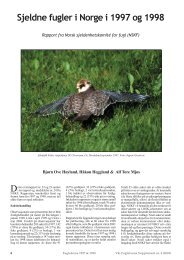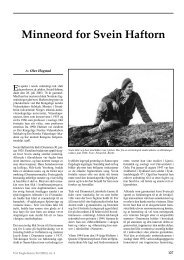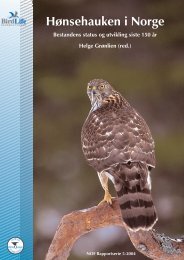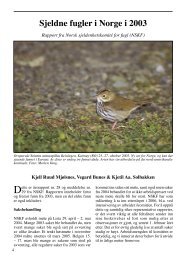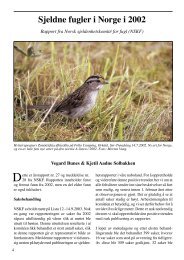Fennoscandian Lesser White-fronted Goose conservation project ...
Fennoscandian Lesser White-fronted Goose conservation project ...
Fennoscandian Lesser White-fronted Goose conservation project ...
Create successful ePaper yourself
Turn your PDF publications into a flip-book with our unique Google optimized e-Paper software.
<strong>Fennoscandian</strong> <strong>Lesser</strong> <strong>White</strong>-<strong>fronted</strong> <strong>Goose</strong> <strong>conservation</strong> <strong>project</strong> – Annual report 1999<br />
New breeding and moulting areas of <strong>Lesser</strong> <strong>White</strong>-<strong>fronted</strong> <strong>Goose</strong><br />
revealed in Indigirka, Yakutia<br />
Evgeny E. Syroechkovski, Jr.<br />
Russian Acad. Sci., Institute of Ecology and Evolution, Leninski prospect 33, Moscow, RUSSIA, e-mail: rgg@eesjr.msk.ru<br />
1. Introduction<br />
The status of the East-Asian population of <strong>Lesser</strong> <strong>White</strong>-Fronted <strong>Goose</strong><br />
(Anser erythropus, later LWfG) is still poorly known. The current<br />
estimate of the total population is at least 14,000 individuals (Iwabuchi<br />
1998), but only fragmented information about some few small breeding<br />
sites in Siberia has been presented in ornithological literature until<br />
recently (Kretchmar et al. 1991, Degtyarev & Perfiliev 1996).<br />
In June–August 1999, the <strong>Goose</strong> and Swan Study Group of Eastern<br />
Europe and North Asia and IPEE, Russian Academy of Sciences arranged<br />
an expedition to Indigirka in Yakutía. The work was carried out as part<br />
of a <strong>project</strong> on surveying important goose areas in co-operation with the<br />
Japanese Association for Wild Geese Protection.<br />
Several new breeding and moulting locations of LWfG were found<br />
in the middle and lower parts of the Indigirka river. The first information<br />
on breeding locations in Abyi Lowland is published by Artyukhov &<br />
Syroechkovski, Jr (1999). Here we present a more detailed review of<br />
the distribution of LWfG at Indigirka.<br />
2. Results<br />
2.1. Breeding distribution<br />
Breeding LWfG were found in the taiga areas of Abyi Lowland. The<br />
main part of the observations was made by A.I. Artyukhov along the<br />
tributaries of Indigirka River north of the Momski Ridge (67°32’N;<br />
144°15’E). In 9 out of 15 study areas in the<br />
taiga zone visited by our expedition in<br />
summer 1999, no LWfG was found.<br />
About 250 birds (including 24 broods)<br />
were observed along the Indigirka River south<br />
of the Momski Ridge. According to interview<br />
data and previously published material, at least<br />
six more areas possessed breeding LWfG (see<br />
Figure 1). All observations of LWfG were<br />
reported from the marginal parts of the Abyi<br />
Lowland not further than 50 km from the<br />
mountains. The preferred habitat of LWfG was<br />
slow-flowing river stretches not wider than 100<br />
m, with numerous branches and islands. No<br />
birds were seen on the Indigirka river and closer<br />
than 5 km from the main river, most likely due<br />
to disturbance and illegal hunting.<br />
The first brood, with 3–5 days old goslings,<br />
was recorded on 27 June. The average brood<br />
size was difficult to estimate. We have the<br />
following data on brood size: 2 broods with 5<br />
young; 6 broods with 4 young, and 2 broods<br />
with 3 young. On 15 July a flock of ca. 20 adults<br />
and 60 young was seen. In some broods it was<br />
not possible to estimate accurately the number<br />
of goslings. If we calculate the approximate<br />
average brood size during the first 3 weeks of<br />
age of the goslings up to mid July, we obtain<br />
an average of about 4 goslings per pair for<br />
single broods, 6 goslings per pair in an<br />
aggregation seen on 15 July, and an average of<br />
5 goslings for all observed broods (n = 20).<br />
Survival in brood aggregations could possibly<br />
be higher than for single broods, but the sample<br />
size is too small to estimate this with certainty.<br />
Syroechkovski, Jr.: New breeding and moulting areas of <strong>Lesser</strong> <strong>White</strong>-<strong>fronted</strong> <strong>Goose</strong> revealed in Indigirka, Yakutia<br />
At the middle stretches of the Uyandina River (68°30’N; 142°30’E),<br />
39 LWfG were registered during 5 days in late June and one pair was<br />
probably breeding (Table 1). Also the Uyandina river consists of<br />
numerous branches and green flood plain pastures where most of the<br />
LWfG were seen. Again, all geese were mostly met at shallow remote<br />
parts of the river that are rarely visited by native people in summer .<br />
2.2. Distribution of moulting non-breeders<br />
Northward moult migration of the non-breeding LWfG is earlier<br />
described from Taimyr (Syroechkovski, Jr. 1996).<br />
During our work in 1999 this phenomenon was also observed<br />
for the East Asian population. <strong>Lesser</strong> <strong>White</strong>-fronts do not moult in<br />
the Indigirka Delta but can be met in the small river valleys west and<br />
east of the delta. The main location of moulting non-breeding LWfG<br />
was found in the basin of the rivers Melkaya and Volchya (about<br />
72ºN, 147ºE).<br />
Hunters from Russkoe Ust’e settlement reported that about 10–<br />
15 years ago a concentration of about 2,500 LWfG was found in the<br />
lower Volchya River. The place have the name “Piskun” (local name<br />
for LWfG) and was regularly visited by hunters who killed 50–300<br />
LWfG every July in the 1980's–early 1990's.<br />
During 1990's the remaining LWfG have moved to smaller rivers<br />
nearby due to increasing disturbance and hunting pressure. In early<br />
July 1999, several hundreds were observed in the area and on 23–25<br />
Figure 1. Distribution of LWFG at Indigirka. Legend symbols: 1 – non-breeding records; 2 –<br />
proved or assumed breeding records; 3 –assumed breeding range; 4 – current distribution of<br />
moulting non-breeders 5 - areas with suitable breeding habitats for the species<br />
39


